Cars
The science of removing bugs from windshields
When you clean bugs off your car's windshield, think of Detroit researcher Clark Wells who spent his career figuring out how best to do this.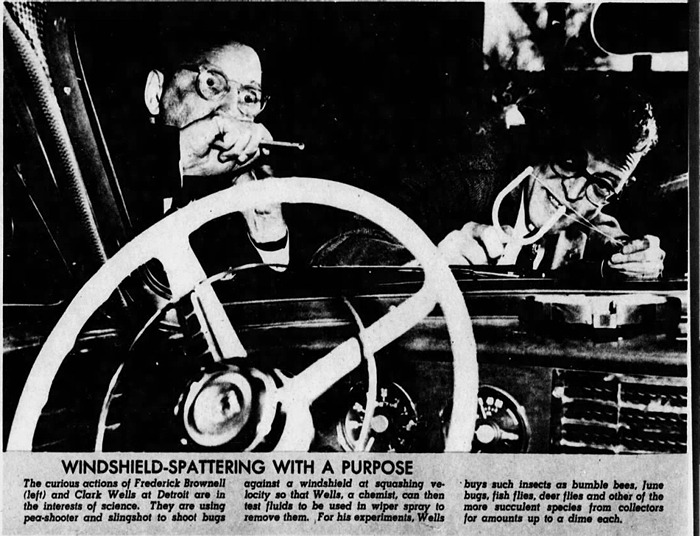
St. Louis Post-Dispatch - Mar 22, 1953
The curious actions of Frederick Brownell (left) and Clark Wells at Detroit are in the interests of science. They are using pea-shooter and slingshot to shoot bugs against a windshield at squashing velocity so that Wells, a chemist, can then test fluids to be used in wiper spray to remove them. For his experiments, Wells buys such insects as bumble bees, June bugs, fish flies, deer flies and other of the more succulent species from collectors for amounts up to a dime each.

Huntsville Times - June 20, 1954
Posted By: Alex - Sat Aug 08, 2020 -
Comments (2)
Category: Insects and Spiders, Science, 1950s, Cars
Nuclear Car Battery
Note: no actual nuclear power involved.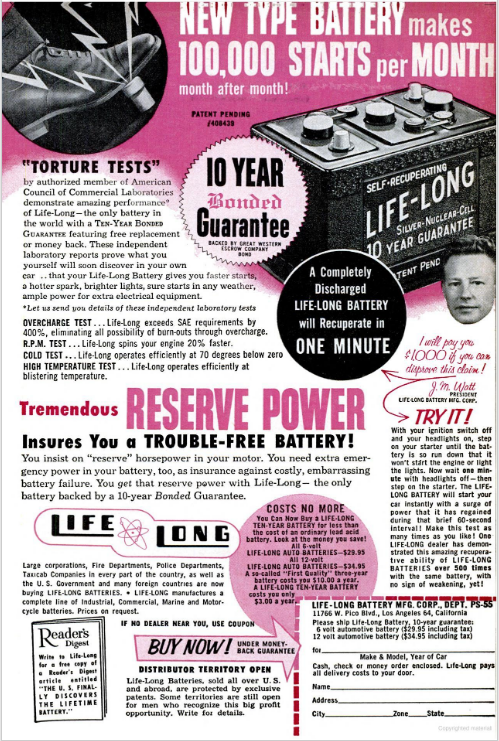
Source.
Posted By: Paul - Fri Jul 03, 2020 -
Comments (3)
Category: Excess, Overkill, Hyperbole and Too Much Is Not Enough, Scams, Cons, Rip-offs, and General Larceny, Atomic Power and Other Nuclear Matters, 1950s, Cars
Drunk Driving Defense
Back in 1971, Melvin Baker offered a novel defense for why he shouldn't have been charged with drunk driving. He was, he said, too drunk to have made an intelligent decision about whether to submit to the breathalyzer test — the results of which led to him being charged. He apparently argued this case all the way up to the New York Supreme Court.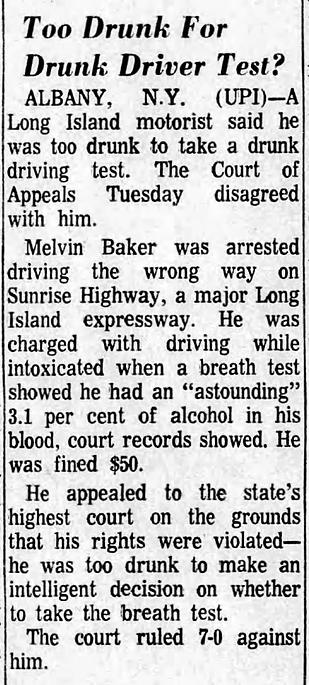
Santa Rosa Press Democrat - July 7, 1971
Details about this case are hard to come by, but this other brief article offers an explanation for why Baker persisted with his seemingly hopeless argument. Because if he had refused to take the test, he would only have had his license suspended. But having taken the test, and failed it, he also faced criminal prosecution. So it was all an elaborate, legalistic ploy to get the lighter penalty.

Long Beach Independent - Sep 7, 1971
Posted By: Alex - Thu May 14, 2020 -
Comments (2)
Category: Inebriation and Intoxicants, Law, 1970s, Cars
Sneezing Protected
This is good to know in the pandemic era. I hope coughing is covered as well.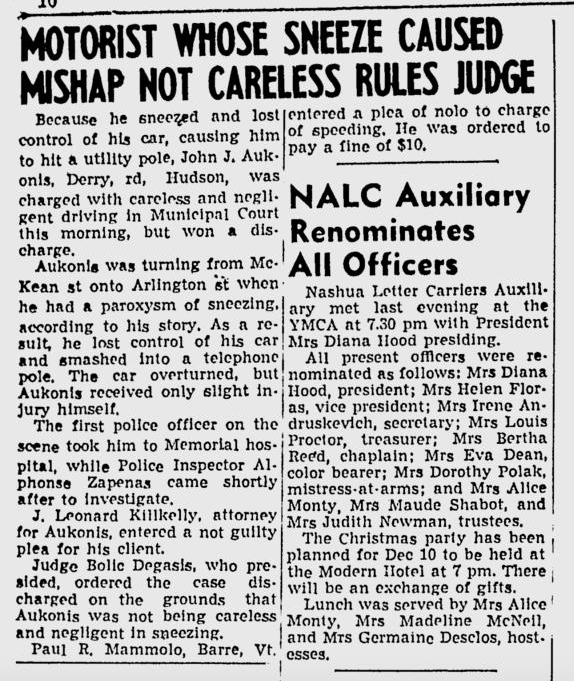
Source.
Posted By: Paul - Fri May 08, 2020 -
Comments (2)
Category: Accidents, Law, 1950s, Cars
Staring Hitchhikers
Will hitchhikers get more rides if they stare at oncoming drivers or if they look away? A 1974 study published in the Journal of Applied Social Psychology attempted to answer this question:In the stare conditions, E stared at the driver of the target vehicle and attempted to fixate on the driver's gaze and maintain this gaze as long as possible until the driver either stopped his vehicle or drove on. In the comparison conditions, E looked anywhere else but at the driver. Thus, on some trials E looked in the general direction of the car; on other trials E looked at his feet, the road, the sky, etc. Es were specifically instructed to neither smile nor frown, and to maintain a casual (neither rigid nor slouching) body postural orientation while soliciting rides.
The two hitchhikers were described as, "both 20 years of age and both dressed in bluejeans and dark coats. The male had short, curly blond hair, and the female, straight, shoulder length blond hair. Both could be described as neat, collegiate, attractive in physical appearance, and of an appropriate age to be hitchhiking."

A hitchhiker in Luxembourg - Aug 1977 (source: wiktionary.org)
(not one of the hitchhikers in the study)
Staring is often interpreted as a threat. So the researchers anticipated that staring at oncoming drivers might result in fewer rides. But the opposite turned out to be true. Which is a useful tip to know if you ever need to hitchhike. But what really helped get a lot of rides was being a single female. From the study:
Contrary to popular belief and hitchhiking folklore , it was no easier for a male-female couple to hitch a ride than a single male, and a mixed sex couple was less successful at soliciting rides than a single female hitchhiker. Although the generality of this conclusion is limited by the fact that it is based upon results obtained by one male and one female E, it is probably the case that couples are less successful hitching rides because of space limitations in the cars they approach. That is, it is more likely that the driver will have room for one additional passenger than that he will have room for two or more additional passengers in his car.
Incidentally, the experimenters never actually ever got in a car with anyone: "After a motorist stopped to pick up one of the hitchhikers, he was politely thanked and given a printed description of the nature of the experiment. No driver expressed any discomfort when he learned that the hitchhiker did not actually want a ride."
Posted By: Alex - Mon May 04, 2020 -
Comments (5)
Category: Science, Experiments, Psychology, 1970s, Cars
Travel sack for dogs

Jalopnik draws attention to a similar, but sturdier-looking "bird's dog palace," also supported by a running board.

Posted By: Alex - Thu Apr 30, 2020 -
Comments (10)
Category: Dogs, 1930s, Cars
Left-Foot Accelerator
Deadly crashes guaranteed, or your money back!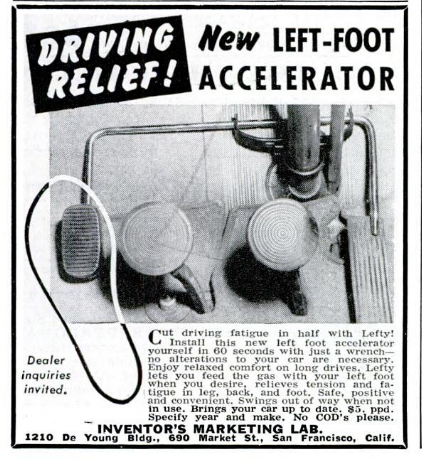
Source.
Posted By: Paul - Wed Apr 22, 2020 -
Comments (1)
Category: Death, Inventions, 1950s, Cars
Light-up Traffic Glove
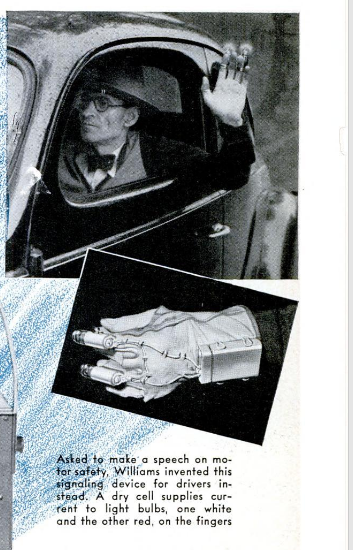
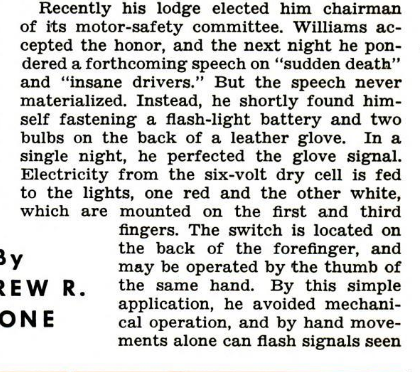

Source.
Posted By: Paul - Wed Mar 25, 2020 -
Comments (5)
Category: Inventions, 1930s, Cars
New car smell perfume
"Now captured in a bottle, the new car fragrance. Savour the smell of success." From Autotrader. £175 for a 1.7 oz bottle.
Posted By: Alex - Mon Mar 16, 2020 -
Comments (2)
Category: Cars, Perfume and Cologne and Other Scents
Skull Headlight Covers
You really need the barbed-wire grill for the total look.
More pix and purchasing at the link.
Posted By: Paul - Sun Feb 23, 2020 -
Comments (3)
Category: Antisocial Activities, Skulls, Bones and Skeletons, Cars

| Who We Are |
|---|
| Alex Boese Alex is the creator and curator of the Museum of Hoaxes. He's also the author of various weird, non-fiction, science-themed books such as Elephants on Acid and Psychedelic Apes. Paul Di Filippo Paul has been paid to put weird ideas into fictional form for over thirty years, in his career as a noted science fiction writer. He has recently begun blogging on many curious topics with three fellow writers at The Inferior 4+1. Contact Us |




